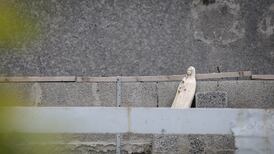It’s only when one opens a map of the capital that the sheer scale of Dublin Port becomes apparent. It takes up a significant chunk of land and coastline on the north and south banks of the river Liffey. It is also the largest and most important port in the State by a considerable distance – shifting more freight and passengers each year than all the other ports combined.
Its masterplan to modernise and double the size of the port by 2040 has been operational for over a decade now. In recent weeks, it unveiled its plans for the final part, a big redevelopment of the South Docks which runs along the Poolbeg peninsula.
In terms of ambition, the 3FM project, as it is called, is an impressive plan. It provides for the construction of two large docks for roll-on/roll-off traffic, as well as lift-on/lift-off traffic where shipping containers are lifted by crane on to the quayside.
The terminal will have the capacity to handle over 350,000 containers each year, a huge number by any yardstick. Overall, the capacity of Dublin Port will double to 77 million tonnes annually by 2040, once the final part of the plan is completed.
READ MORE
It will also involve some big changes to the landscape and seascape. A new bridge will be constructed across the river Liffey close to the Tom Clarke/Eastlink Bridge, but one that will be dedicated to freight traffic. A new 2km road will be built across the water along the southern banks of the docks to accommodate more traffic. There will be 16km of bicycle lanes plus the capacity to take a new Luas line to the former Glass Bottle site in Poolbeg (where new housing will be built).
[ Eamon Ryan raises ‘significant concerns’ over Dublin Port revamp plansOpens in new window ]
In an unprecedented move, Ryan has written to the chairman of the Dublin Port Company, Jerry Grant, setting out his objections to the proposed expansion. From the first paragraph, his intention is clear.
“I am troubled by how this final phase of Dublin Port’s masterplan reflects a continued reliance on unsustainable models of maritime trade and logistics that run counter to our national commute, circular economy, housing and biodiversity objectives.”
The plan provides for a doubling of capacity of the port by 2040. Ryan has questioned this. “I have a problem with that. I don’t believe we need all this additional capacity.”
Ryan told The Irish Times that Dublin Port has not explained to him where the extra volume of capacity will come from over the next 17 years. He said the country’s reliance on imports will lessen as Ireland moves away from importing fossil fuels for transport and energy, and as the circular economy (which is less reliant on imports) becomes more prominent.
[ New bridge over the Liffey: What do plans for Dublin Port look like?Opens in new window ]
His second big concern is with the plan’s reliance on road transport and the complete absence of rail freight. He said the country needed to switch from HGVs on roads to rail freight. “We are far better to put the containers on to a train (at the docks) and bring them to a marshalling yard west of Dublin, from where they would then be distributed around the country.
“The biggest problem we have (in meeting climate emission targets) is with road haulage. That’s the area where we are not delivering. If you think about all those containers, thousands are being put on the M50 which is choked with traffic and at over capacity. So when we are relying on trucks, it’s not just a climate issue, it’s also a transport issue. I have real concerns with this.”
In the letter, Ryan expresses frustration at the slow rate of progress in negotiations between the port company and the Land Development Agency. Bluntly, he says the port should cede three blocks of land it owns between East Wall and the Port Tunnel. One is used to store new vehicles which have been imported into the State. Ryan states that three blocks “should provide a valuable resource to help meet our housing needs in the city”.
Another bone of contention for him is that, under the plan, a large unused site on the Poolbeg peninsula near the sea (and overlooking Sandymount Strand and Seán Moore Park) would be used to store hundred of containers.
Ryan has objected to this aspect of the plan, saying it would have “significant implications for land use on the Poolbeg peninsula”.
The use of these lands would block the expansion of the nearby Poolbeg nature reserve. He says this “sensitive site” should instead be designated as a nature reserve.
The Port Company is an independent State body and the Minister can’t veto its plans. However, politically, there is an expectation that State bodies would adhere to State policy in such matters.













